NISSAN 350Z 2003 Z33 Owners Manual
Manufacturer: NISSAN, Model Year: 2003, Model line: 350Z, Model: NISSAN 350Z 2003 Z33Pages: 227, PDF Size: 2.39 MB
Page 211 of 227
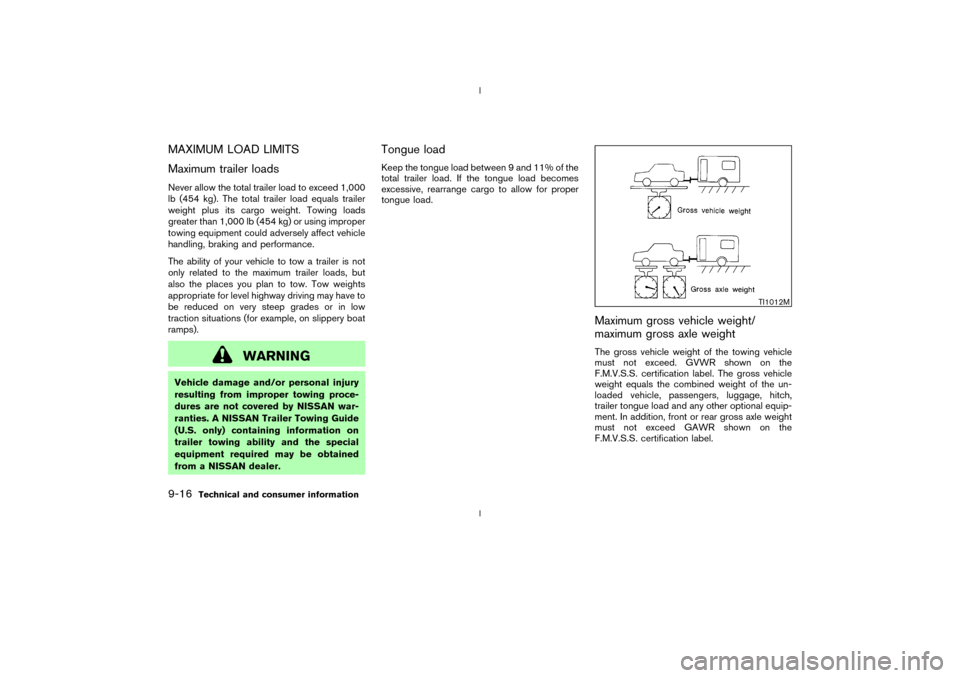
MAXIMUM LOAD LIMITS
Maximum trailer loadsNever allow the total trailer load to exceed 1,000
lb (454 kg). The total trailer load equals trailer
weight plus its cargo weight. Towing loads
greater than 1,000 lb (454 kg) or using improper
towing equipment could adversely affect vehicle
handling, braking and performance.
The ability of your vehicle to tow a trailer is not
only related to the maximum trailer loads, but
also the places you plan to tow. Tow weights
appropriate for level highway driving may have to
be reduced on very steep grades or in low
traction situations (for example, on slippery boat
ramps).
WARNING
Vehicle damage and/or personal injury
resulting from improper towing proce-
dures are not covered by NISSAN war-
ranties. A NISSAN Trailer Towing Guide
(U.S. only) containing information on
trailer towing ability and the special
equipment required may be obtained
from a NISSAN dealer.
Tongue loadKeep the tongue load between 9 and 11% of the
total trailer load. If the tongue load becomes
excessive, rearrange cargo to allow for proper
tongue load.
Maximum gross vehicle weight/
maximum gross axle weightThe gross vehicle weight of the towing vehicle
must not exceed. GVWR shown on the
F.M.V.S.S. certification label. The gross vehicle
weight equals the combined weight of the un-
loaded vehicle, passengers, luggage, hitch,
trailer tongue load and any other optional equip-
ment. In addition, front or rear gross axle weight
must not exceed GAWR shown on the
F.M.V.S.S. certification label.
TI1012M
9-16
Technical and consumer information
Z
02.9.13/Z33-D/V5.0
X
Page 212 of 227
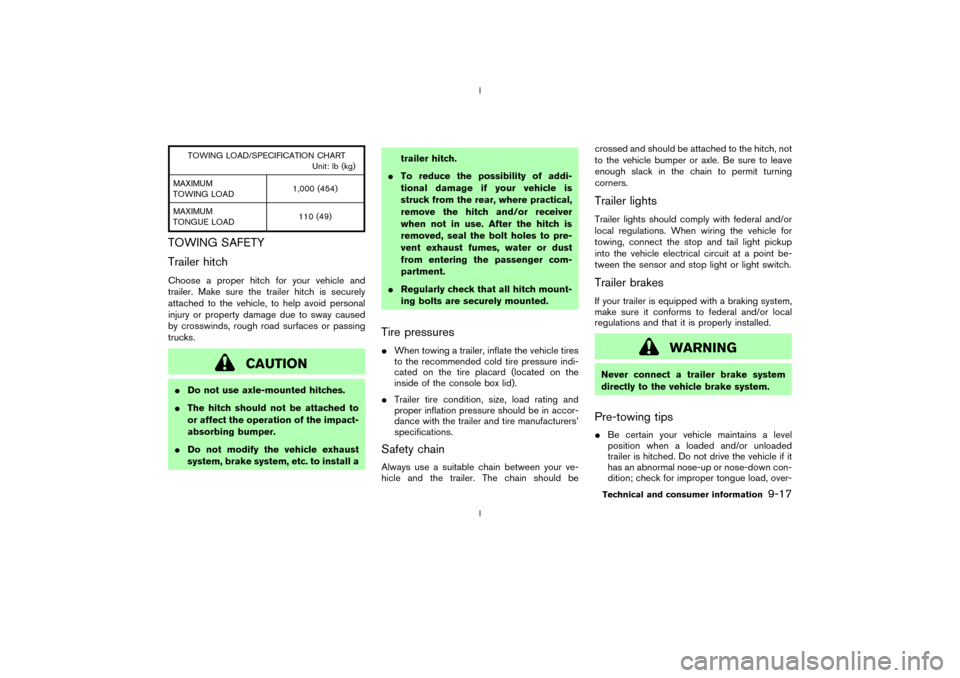
TOWING LOAD/SPECIFICATION CHART
Unit: lb (kg)
MAXIMUM
TOWING LOAD1,000 (454)
MAXIMUM
TONGUE LOAD110 (49)
TOWING SAFETY
Trailer hitchChoose a proper hitch for your vehicle and
trailer. Make sure the trailer hitch is securely
attached to the vehicle, to help avoid personal
injury or property damage due to sway caused
by crosswinds, rough road surfaces or passing
trucks.
CAUTION
IDo not use axle-mounted hitches.
IThe hitch should not be attached to
or affect the operation of the impact-
absorbing bumper.
IDo not modify the vehicle exhaust
system, brake system, etc. to install atrailer hitch.
ITo reduce the possibility of addi-
tional damage if your vehicle is
struck from the rear, where practical,
remove the hitch and/or receiver
when not in use. After the hitch is
removed, seal the bolt holes to pre-
vent exhaust fumes, water or dust
from entering the passenger com-
partment.
IRegularly check that all hitch mount-
ing bolts are securely mounted.
Tire pressuresIWhen towing a trailer, inflate the vehicle tires
to the recommended cold tire pressure indi-
cated on the tire placard (located on the
inside of the console box lid).
ITrailer tire condition, size, load rating and
proper inflation pressure should be in accor-
dance with the trailer and tire manufacturers'
specifications.Safety chainAlways use a suitable chain between your ve-
hicle and the trailer. The chain should becrossed and should be attached to the hitch, not
to the vehicle bumper or axle. Be sure to leave
enough slack in the chain to permit turning
corners.
Trailer lightsTrailer lights should comply with federal and/or
local regulations. When wiring the vehicle for
towing, connect the stop and tail light pickup
into the vehicle electrical circuit at a point be-
tween the sensor and stop light or light switch.Trailer brakesIf your trailer is equipped with a braking system,
make sure it conforms to federal and/or local
regulations and that it is properly installed.
WARNING
Never connect a trailer brake system
directly to the vehicle brake system.Pre-towing tipsIBe certain your vehicle maintains a level
position when a loaded and/or unloaded
trailer is hitched. Do not drive the vehicle if it
has an abnormal nose-up or nose-down con-
dition; check for improper tongue load, over-Technical and consumer information
9-17
Z
02.9.13/Z33-D/V5.0
X
Page 213 of 227

load, worn suspension or other possible
causes of either condition.
IAlways secure items in the trailer to prevent
load shifts while driving.
IBe certain your rear view mirrors conform to
all federal, state or local regulations. If not,
install any mirrors required for towing before
driving the vehicle.
Trailer towing tipsIn order to gain skill and an understanding of the
vehicle's behavior, you should practice turning,
stopping and backing up in an area which is free
from traffic. Steering stability, and braking per-
formance will be somewhat different than under
normal driving conditions.
IAlways secure items in the trailer to prevent
load shift while driving.
IAvoid abrupt starts, acceleration or stops.
IAvoid sharp turns or lane changes.
IAlways drive your vehicle at a moderate
speed.
IAlways block the wheels on both vehicle and
trailer when parking. Parking on a slope is not
recommended; however, if you must do so,
and if your vehicle is equipped with automatic
transmission, first apply the parking brakeand block the wheels, and then move the
transmission selector lever into the P (Park)
position. If you move the selector lever to the
P (Park) position before blocking the wheels
and applying the parking brake, the transmis-
sion may get damaged.
IWhen going down a hill, shift into a lower
gear and use the engine braking effect.
When ascending on a long grade, downshift
the transmission to a lower gear and reduce
speed to reduce chances of engine overload-
ing and/or overheating.
IIf the engine coolant rises to an extremely
high temperature when the air conditioning
system is on, turn off the air conditioner.
Coolant heat can be additionally vented by
opening the windows, switching the fan con-
trol to high and setting the temperature con-
trol to the HOT position.
ITrailer towing consumes more fuel than nor-
mal circumstances.
IAvoid towing a trailer for the first 500 miles
(800 km).
IHave your vehicle serviced more often than at
intervals specified in the recommended main-
tenance schedule.
IWhen making a turn, your trailer wheels will
be closer to the inside of the turn than yourvehicle wheels. To compensate for this, make
a larger than normal turning radius during the
turn.
ICrosswinds and rough roads will adversely
affect vehicle/trailer handling, possibly caus-
ing vehicle sway. When being passed by
larger vehicles, be prepared for possible
changes in crosswinds that could affect ve-
hicle handling. If swaying does occur, firmly
grip the steering wheel, steer straight ahead,
and immediately (but gradually) reduce ve-
hicle speed. This combination will help stabi-
lize the vehicle. Never increase speed.
IBe careful when passing other vehicles.
Passing while towing a trailer requires con-
siderably more distance than normal passing.
Remember the length of the trailer must also
pass the other vehicle before you can safely
change lanes.
ITo maintain engine braking efficiency and
electrical charging performance, do not use
6th gear (manual transmission) or 5th posi-
tion (automatic transmission).
IAvoid holding the brake pedal down too long
or too frequently. This could cause the brakes
to overheat, resulting in reduced braking ef-
ficiency.
When towing a trailer, change transmis-9-18
Technical and consumer information
Z
02.9.13/Z33-D/V5.0
X
Page 214 of 227
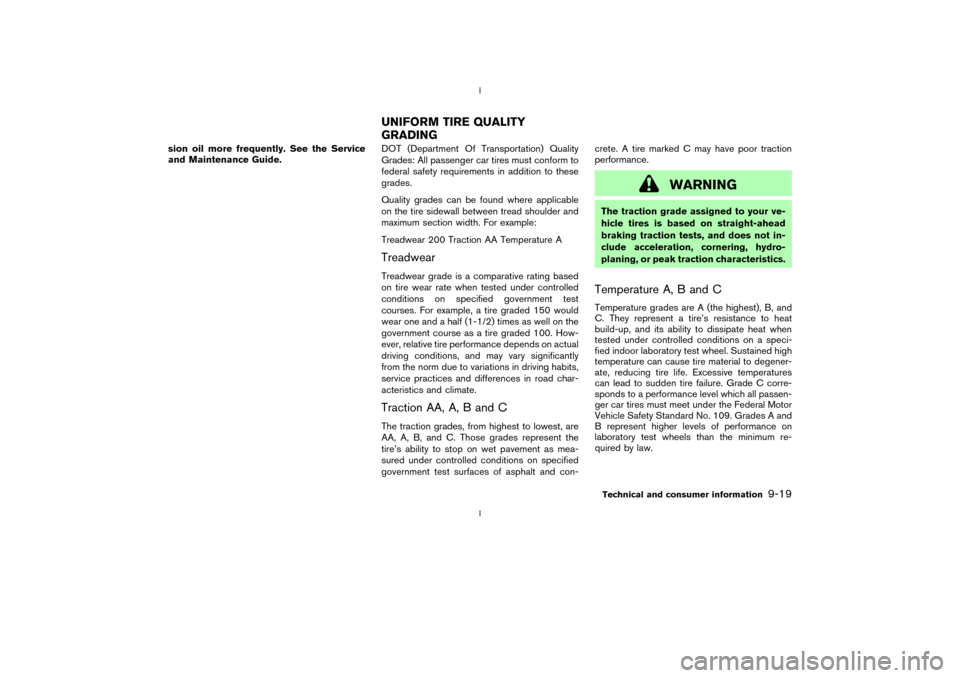
sion oil more frequently. See the Service
and Maintenance Guide.DOT (Department Of Transportation) Quality
Grades: All passenger car tires must conform to
federal safety requirements in addition to these
grades.
Quality grades can be found where applicable
on the tire sidewall between tread shoulder and
maximum section width. For example:
Treadwear 200 Traction AA Temperature A
TreadwearTreadwear grade is a comparative rating based
on tire wear rate when tested under controlled
conditions on specified government test
courses. For example, a tire graded 150 would
wear one and a half (1-1/2) times as well on the
government course as a tire graded 100. How-
ever, relative tire performance depends on actual
driving conditions, and may vary significantly
from the norm due to variations in driving habits,
service practices and differences in road char-
acteristics and climate.Traction AA, A, B and CThe traction grades, from highest to lowest, are
AA, A, B, and C. Those grades represent the
tire's ability to stop on wet pavement as mea-
sured under controlled conditions on specified
government test surfaces of asphalt and con-crete. A tire marked C may have poor traction
performance.
WARNING
The traction grade assigned to your ve-
hicle tires is based on straight-ahead
braking traction tests, and does not in-
clude acceleration, cornering, hydro-
planing, or peak traction characteristics.Temperature A, B and CTemperature grades are A (the highest), B, and
C. They represent a tire's resistance to heat
build-up, and its ability to dissipate heat when
tested under controlled conditions on a speci-
fied indoor laboratory test wheel. Sustained high
temperature can cause tire material to degener-
ate, reducing tire life. Excessive temperatures
can lead to sudden tire failure. Grade C corre-
sponds to a performance level which all passen-
ger car tires must meet under the Federal Motor
Vehicle Safety Standard No. 109. Grades A and
B represent higher levels of performance on
laboratory test wheels than the minimum re-
quired by law.
UNIFORM TIRE QUALITY
GRADING
Technical and consumer information
9-19
Z
02.9.13/Z33-D/V5.0
X
Page 215 of 227
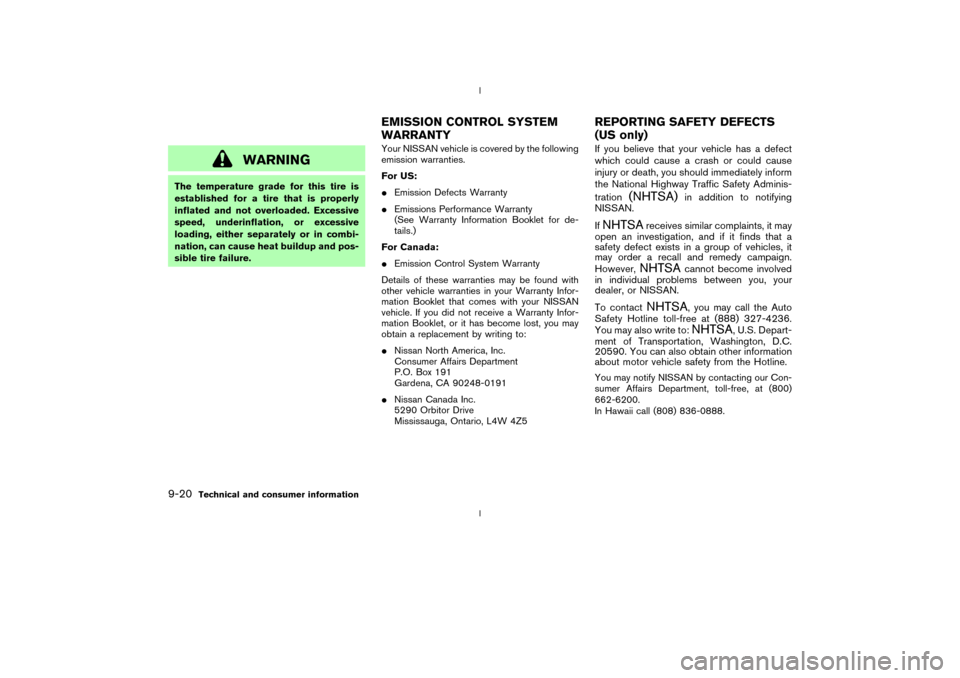
WARNING
The temperature grade for this tire is
established for a tire that is properly
inflated and not overloaded. Excessive
speed, underinflation, or excessive
loading, either separately or in combi-
nation, can cause heat buildup and pos-
sible tire failure.Your NISSAN vehicle is covered by the following
emission warranties.
For US:
IEmission Defects Warranty
IEmissions Performance Warranty
(See Warranty Information Booklet for de-
tails.)
For Canada:
IEmission Control System Warranty
Details of these warranties may be found with
other vehicle warranties in your Warranty Infor-
mation Booklet that comes with your NISSAN
vehicle. If you did not receive a Warranty Infor-
mation Booklet, or it has become lost, you may
obtain a replacement by writing to:
INissan North America, Inc.
Consumer Affairs Department
P.O. Box 191
Gardena, CA 90248-0191
INissan Canada Inc.
5290 Orbitor Drive
Mississauga, Ontario, L4W 4Z5
If you believe that your vehicle has a defect
which could cause a crash or could cause
injury or death, you should immediately inform
the National Highway Traffic Safety Adminis-
tration
(NHTSA)
in addition to notifying
NISSAN.
If
NHTSA
receives similar complaints, it may
open an investigation, and if it finds that a
safety defect exists in a group of vehicles, it
may order a recall and remedy campaign.
However,NHTSA
cannot become involved
in individual problems between you, your
dealer, or NISSAN.
To contact
NHTSA
, you may call the Auto
Safety Hotline toll-free at (888) 327-4236.
You may also write to:NHTSA
, U.S. Depart-
ment of Transportation, Washington, D.C.
20590. You can also obtain other information
about motor vehicle safety from the Hotline.
You may notify NISSAN by contacting our Con-
sumer Affairs Department, toll-free, at (800)
662-6200.
In Hawaii call (808) 836-0888.
EMISSION CONTROL SYSTEM
WARRANTYREPORTING SAFETY DEFECTS
(US only)
9-20
Technical and consumer information
Z
02.9.13/Z33-D/V5.0
X
Page 216 of 227
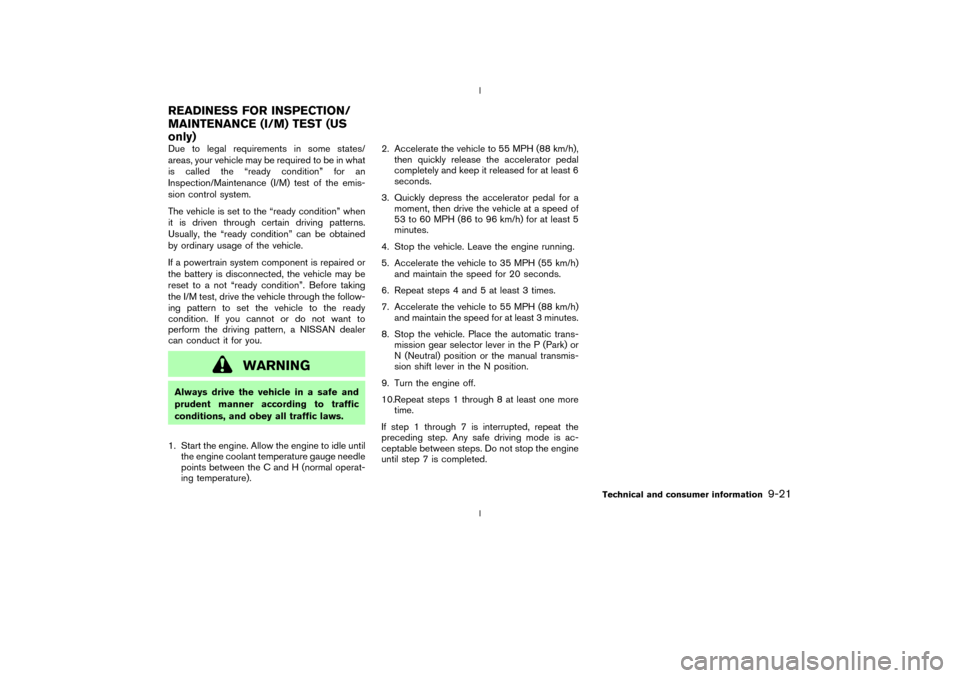
Due to legal requirements in some states/
areas, your vehicle may be required to be in what
is called the ªready conditionº for an
Inspection/Maintenance (I/M) test of the emis-
sion control system.
The vehicle is set to the ªready conditionº when
it is driven through certain driving patterns.
Usually, the ªready conditionº can be obtained
by ordinary usage of the vehicle.
If a powertrain system component is repaired or
the battery is disconnected, the vehicle may be
reset to a not ªready conditionº. Before taking
the I/M test, drive the vehicle through the follow-
ing pattern to set the vehicle to the ready
condition. If you cannot or do not want to
perform the driving pattern, a NISSAN dealer
can conduct it for you.
WARNING
Always drive the vehicle in a safe and
prudent manner according to traffic
conditions, and obey all traffic laws.
1. Start the engine. Allow the engine to idle until
the engine coolant temperature gauge needle
points between the C and H (normal operat-
ing temperature).2. Accelerate the vehicle to 55 MPH (88 km/h),
then quickly release the accelerator pedal
completely and keep it released for at least 6
seconds.
3. Quickly depress the accelerator pedal for a
moment, then drive the vehicle at a speed of
53 to 60 MPH (86 to 96 km/h) for at least 5
minutes.
4. Stop the vehicle. Leave the engine running.
5. Accelerate the vehicle to 35 MPH (55 km/h)
and maintain the speed for 20 seconds.
6. Repeat steps 4 and 5 at least 3 times.
7. Accelerate the vehicle to 55 MPH (88 km/h)
and maintain the speed for at least 3 minutes.
8. Stop the vehicle. Place the automatic trans-
mission gear selector lever in the P (Park) or
N (Neutral) position or the manual transmis-
sion shift lever in the N position.
9. Turn the engine off.
10.Repeat steps 1 through 8 at least one more
time.
If step 1 through 7 is interrupted, repeat the
preceding step. Any safe driving mode is ac-
ceptable between steps. Do not stop the engine
until step 7 is completed.READINESS FOR INSPECTION/
MAINTENANCE (I/M) TEST (US
only)
Technical and consumer information
9-21
Z
02.9.13/Z33-D/V5.0
X
Page 217 of 227

A genuine NISSAN Service Manual is the best
source of service and repair information for your
vehicle. Filled with wiring diagrams, illustrations
and step-by-step diagnostic and adjustment
procedures, this manual is the same one used by
the factory trained technicians working at autho-
rized NISSAN dealerships. Also available are
genuine NISSAN Owner's Manuals, and genu-
ine NISSAN Service and Owner's Manuals for
older NISSAN models.In the USA:
For current pricing and availability of genuine
NISSAN Service Manualsfor the 2000 model
year and later, contact:
Tweddle Litho Company
1-800-639-8841
www.nissan-techinfo.com
For current pricing and availability of genuine
NISSAN Service Manualsfor the 1999 model
year and prior, see a NISSAN dealer, or contact:
DDS Distribution Services, Ltd.
20770 Westwood Dr.
Strongsville OH 44136
1-800-247-5321For current pricing and availability of genuine
NISSAN Owner's Manualsfor the 2003
model year and prior, see a NISSAN dealer, or
contact:
DDS Distribution Services, Ltd.
20770 Westwood Dr.
Strongsville OH 44136
1-800-247-5321
In Canada:
To purchase a copy of a genuine NISSAN
Service Manual or Owner's Manual please con-
tact your nearest NISSAN dealer. For the phone
number and location of a NISSAN Dealer in your
area call the NISSAN Satisfaction Center at
1-800-387-0122 and a bilingual
NISSAN representative will assist you.
Also available are Genuine NISSAN Service and
Owner's Manuals for older NISSAN models.
IN THE EVENT OF A COLLISIONUnfortunately, accidents do occur. In this unlikely
event, there is some important information you
should know. Many insurance companies rou-
tinely authorize the use of non-genuine collision
parts in order to cut costs, among other reasons.
OWNER'S MANUAL/SERVICE
MANUAL ORDER INFORMATION9-22
Technical and consumer information
Z
02.9.13/Z33-D/V5.0
X
Page 218 of 227

Insist on the use of Genuine Nissan
Collision Parts!If you want your vehicle to be restored using
parts made to Nissan's original exacting speci-
fications Ð if you want to help it to last and hold
its resale value, the solution is simple.Tell your
insurance agent and your repair shop to
only use Genuine Nissan Collision Parts.
Nissan does not warrant non-Nissan parts, nor
does Nissan's warranty apply to damage caused
by a non-genuine part.
Using Genuine Nissan Parts can help protect
your personal safety, preserve your warranty
protection and maintain the resale value of your
vehicle. And if your vehicle was leased, using
Genuine Nissan Parts may prevent or limit un-
necessary excess wear and tear expenses at the
end of your lease.
Nissan designs its hoods with crumple zones to
minimize the risk that the hood will penetrate the
windshield of your vehicle in an accident. Non-
genuine (imitation) parts may not provide such
built in safeguards. Also, non-genuine parts of-
ten show premature wear, rust and corrosion.Why should you take a chance?In over 40 states, the law says you must be
advised if non-genuine parts are used to repair
your vehicle. And some states have enactedlaws that restrict insurance companies from
authorizing the use of non-genuine collision
parts during the new vehicle warranty. These
laws help protect you, so you can take action to
protect yourself.
It's your right!If you should need further information visit us at:
www.nissanusa.com.
Technical and consumer information
9-23
Z
02.9.13/Z33-D/V5.0
X
Page 219 of 227

MEMO9-24
Technical and consumer information
Z
02.9.13/Z33-D/V5.0
X
Page 220 of 227

10 Index
A
ABS (Anti-lock brake system)................................ 5-20
Air bag ON/OFF switch .......................................... 1-21
Air bag system
Front (See supplemental front air bag
system) .................................................................. 1-11
Side and curtain (See supplemental side air bag
and curtain side-impact air bag system) ...... 1-13
Air bag warning labels ............................................. 1-16
Air bag warning light .................................... 1-16, 2-14
Air cleaner housing filter.......................................... 8-18
Air conditioner
Air conditioner operation ..................................... 4-3
Air conditioner service ................................ 4-3, 4-6
Air conditioner specification label .................. 9-12
Air conditioning system refrigerant and lubricant
recommendations ......................................... 4-6, 9-6
Heater and air conditioner (automatic)............ 4-3
Alcohol, drugs and driving......................................... 5-5
Anchor point location, Top tether strap ............. 1-27
Anti-lock Brake System (ABS) .............................. 5-20
Anti-lock brake warning light.................................. 2-11
Appearance care
Exterior appearance care .................................... 7-2
Interior appearance care ..................................... 7-4
Ashtrays (See cigarette lighter and ashtray)...... 2-28
Audible reminders ..................................................... 2-16
Audio operation precautions ..................................... 4-7Audio system ................................................................ 4-6
Autochanger
Compact Disc (CD) ........................................... 4-17
Automatic
Anti-glare inside mirror ...................................... 3-13
Automatic transmission fluid (ATF) ................ 8-12
Driving with automatic transmission........ 5-5, 5-9
Transmission selector lever lock release ...... 5-12
Avoiding collision and rollover .................................. 5-4
B
Battery .......................................................................... 8-15
Battery saver system ......................................... 2-22
Battery replacement, (See remote keyless entry
system) ........................................................................... 3-7
Before starting the engine ......................................... 5-8
Belts (See drive belts) ............................................. 8-17
Brake
Anti-lock brake system (ABS) ......................... 5-20
Brake and clutch fluid ....................................... 8-13
Brake booster ...................................................... 8-22
Brake fluid............................................................. 8-13
Brake pedal .......................................................... 8-21
Brake pedal check ............................................. 8-21
Brake system ....................................................... 5-20
Parking brake check............................... 5-14, 8-21
Parking brake operation .................................... 5-14
Warning light ....................................................... 2-12Break-in schedule ..................................................... 5-17
Bulb check/instrument panel.................................. 2-11
Bulb replacement ...................................................... 8-25
C
Capacities and recommended fuel/lubricants...... 9-2
Car phone or CB radio............................................ 4-19
Cassette player (See audio system) .................... 4-16
Catalytic converter, Three way catalyst ................. 5-3
CD care and cleaning .............................................. 4-19
Child restraints ........................................................... 1-25
Top tether strap anchor point location ......... 1-27
Installation on front passenger seat............... 1-28
Precautions on child restraints........................ 1-25
With top tether strap ......................................... 1-27
Child safety ................................................................. 1-20
Chimes, Audible reminders..................................... 2-16
Cigarette lighter and ashtray .................................. 2-28
Circuit breaker, Fusible link .................................... 8-23
Cleaning exterior and interior .......................... 7-2, 7-4
Clock ............................................................................ 2-27
Clutch fluid.................................................................. 8-14
Cold weather driving ................................................ 5-24
Compact Disc (CD) changer operation .............. 4-17
Compact Disc (CD) player (See audio
system) ......................................................................... 4-11
Compact spare tire ................................................... 8-33
Console box................................................................ 2-31
Z
02.9.13/Z33-D/V5.0
X